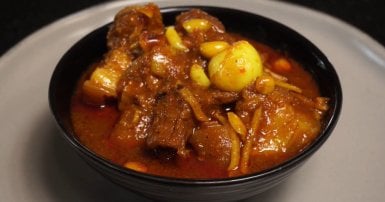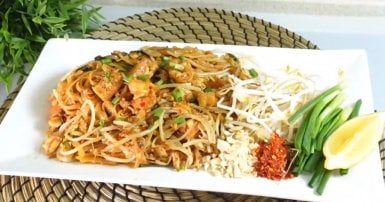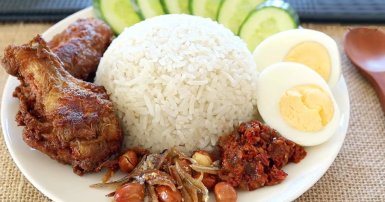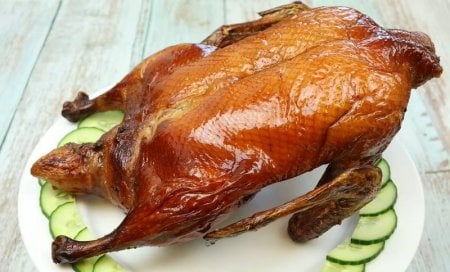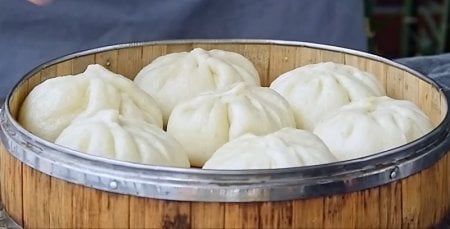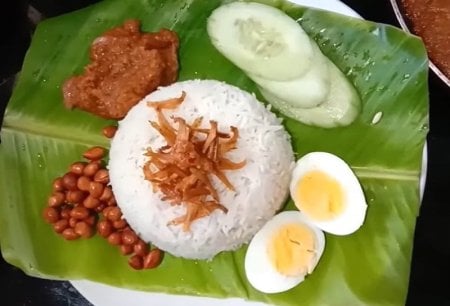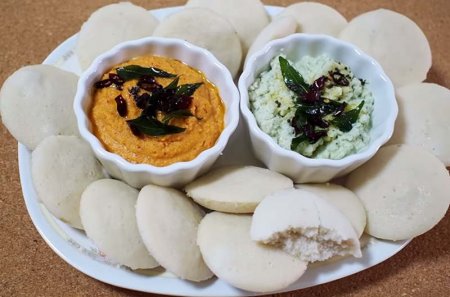Thai soups are a tantalizing blend of aromatic herbs, spices, and flavorful broths that create a harmonious explosion of taste. Renowned for their balance of sweet, sour, salty, and spicy notes, Thai soups offer a diverse range of options. Tom Yum, with its zesty lemongrass and chili kick, is an iconic favorite, while Tom Kha Gai charms with coconut milk and galangal. Rich, hearty Khao Soi, a Northern Thai specialty, brings depth with its curry-based broth. Whether it's the comforting Tom Jued or the robust Tom Klong, Thai soups exemplify the artful mastery of flavors in Thai cuisine.
Tom Yum
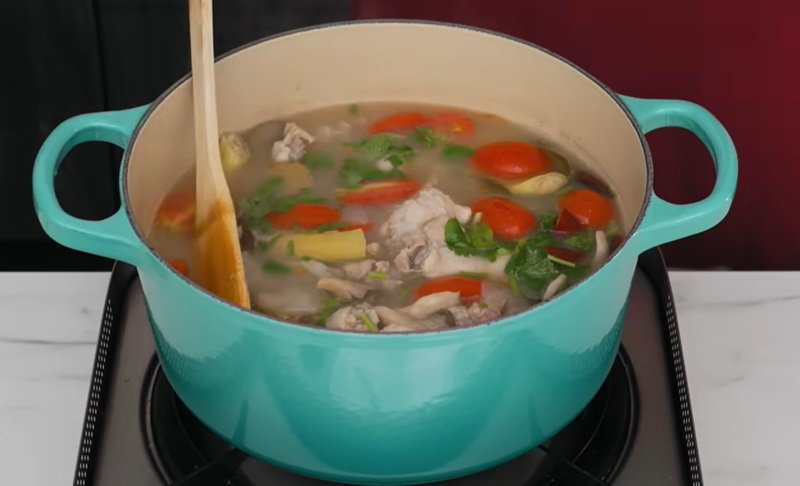
Tom yum, a revered Thai soup, tantalizes taste buds with its hot and sour fusion. Typically featuring shrimp, its robust flavors, drawn from aromatic ingredients like kaffir lime leaves, lemongrass, and galangal, contribute to its popularity. The name itself reflects the boiling (tom) and mixing (yam) process. The soup base, be it water, coconut milk, or broth, forms the canvas for the infusion of these flavorful components. Fresh elements, including shallots, chilis, and garlic, are sliced, pounded, and simmered, creating a symphony of tastes. For shrimp-based variants, the shells and heads add depth to the broth.
Tom yum epitomizes Thai culinary prowess, captivating enthusiasts with its dynamic combination of heat, sourness, and aromatic richness. Whether enjoyed for its comforting warmth or savored for its bold flavors, tom yum remains a culinary treasure that reflects the artistry of Thai gastronomy.
Tom Kha Kai
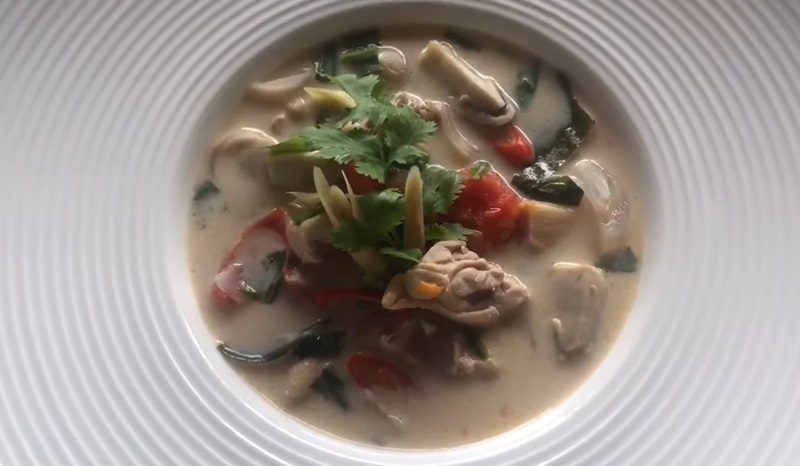
Tom kha kai, also known as Thai coconut soup, is a delightful and iconic Thai dish that traces its roots back to around 1890, making its debut in a Thai recipe book. Initially called Tom kha pet, the earliest recorded version featured duck and young galangal in a coconut milk-based curry. However, as culinary preferences evolved, chicken became the more popular protein choice, resulting in the well-known version called Tom kha kai, where kai means chicken in Thai. Over time, shrimp has also become a favored protein option, leading to the variation known as Tom kha kung.
Tom kha shares fundamental ingredients with another Thai favorite, Tom yam. However, what sets Tom kha apart is the addition of coconut milk. The addition of coconut milk imparts a lusciously creamy texture and a gentle, sweet flavor, providing a delightful contrast to the tangy and spicy notes found in Tom yam. The evolution of Tom kha showcases the dynamic nature of Thai cuisine and its ability to adapt while preserving its authentic flavors, offering a delicious exploration of Thai culinary heritage.
Nam Tok
-1702287351.jpg)
Nam tok, translating to waterfall in Lao and Thai, manifests as either a meat salad or a spicy soup in Southeast Asian cuisine. In Lao culinary traditions, it takes the form of a sliced beef steak, distinct from the minced meat version of larb, the national dish of Laos. Meanwhile, in Central Thailand, nam tok predominantly refers to a spicy soup enriched with raw cow or pig's blood, a common practice in Thai cuisine to enhance various noodle dishes. A popular variant is kuai-tiao mu nam tok, featuring noodles, green vegetables, broth, bean sprouts, blood, dumplings, liver pieces, pork, and spices. Often found in street-side stalls, this soup boasts an intense, rich flavor. Beyond Thailand, nam tok also serves as a meat dish in Isan and Lao cuisine, akin to the renowned lap (larb), showcasing the dish's regional variations and cultural adaptability.
Kaeng Som
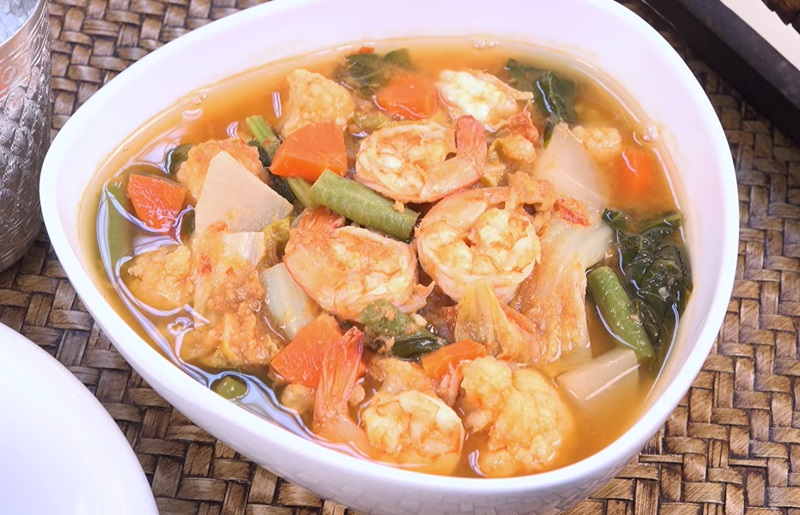
Kaeng som, known as gaeng som in Thai, Asam rebus in Malaysian, and also referred to as sour curry, is a tantalizingly sour and spicy fish curry or soup celebrated in Southeast Asian culinary traditions. Renowned for its distinctively sour flavor, the curry achieves this profile through the inclusion of tamarind (makham), imparting a delightful tanginess to the dish. As a signature Southeast Asian creation, kaeng som showcases a harmonious blend of spices, herbs, and vegetables that contribute to its rich and complex taste.
Palm sugar plays a pivotal role in this recipe, introducing a delicate sweetness that balances the sourness and heat of the curry. The result is a vibrant and dynamic culinary experience that captivates the palate. The interplay of tamarind, palm sugar, and an array of aromatic ingredients creates a symphony of flavors, making kaeng som a beloved dish that exemplifies the diverse and nuanced culinary heritage of Southeast Asia. Whether enjoyed as a soup or served alongside rice, kaeng som continues to be a cherished and flavorful representation of the region's gastronomic expertise.
Pork Blood Soup
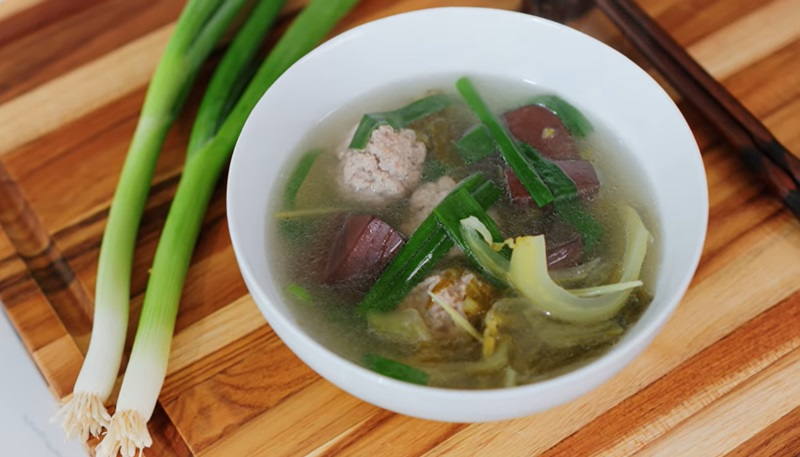
Pork blood soup is a distinctive dish where pork blood takes center stage as the primary ingredient. This unique soup often features additional components like barley and flavorful herbs such as marjoram, creating a rich and aromatic culinary experience. In some variations, coagulated pork blood is combined with other pork offal, including intestine, liver, and heart, adding depth and complexity to the dish.
In Thai cuisine, Guay Tiao Namtok stands out as a noteworthy example of pork blood soup. This Thai noodle dish showcases pork blood as a key element in its soup base, offering a unique twist to the culinary landscape. The origins of this soup may trace back to Chinese cuisine, as historical migrations brought southern Chinese influences to Thailand over the centuries.
Pork blood soup exemplifies the intersection of diverse culinary traditions, highlighting the innovation and adaptation that characterize regional cuisines. Whether enjoyed for its bold flavors or appreciated for its cultural connections, this soup stands as a testament to the rich tapestry of global culinary influences.
Ant Egg Soup
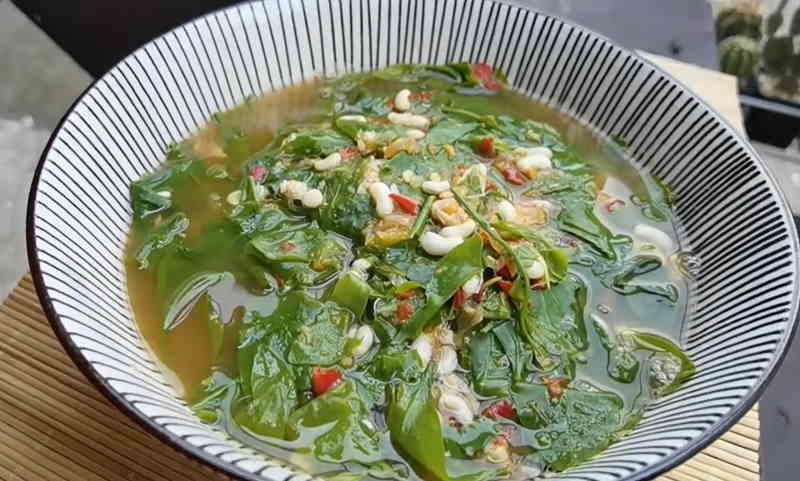
Ant egg soup, a gastronomic treasure crafted from the delicate eggs of the weaver ant species stands as a unique culinary delight. This exceptional soup, deeply rooted in northern Lao and Thai cuisine, offers a sour flavor with a nostalgic touch of the countryside. Beyond being a central ingredient in dedicated soups, ant eggs often enhance various other soup varieties as a flavorful garnish, contributing to the rich tapestry of regional culinary offerings.
In northern Laos and Thailand, ant egg soup holds significance as a traditional dish among subsistence farmers, providing a valuable protein source. Known as Gaeng Khai Moht in Laos, this dish reflects the culinary ingenuity of communities relying on locally available ingredients. In Isan, the northeastern region of Thailand, different variations of ant egg soup are also embraced.
Leigong root soup and ant egg shine as a local specialty in China's Hainan Island, where Miao and Li villages in Wuzhishan City preserve and celebrate this traditional culinary heritage. The widespread enjoyment of ant egg soup across these diverse regions highlights its cultural resonance and culinary versatility in creating distinctive and memorable dining experiences.
Tom Khlong
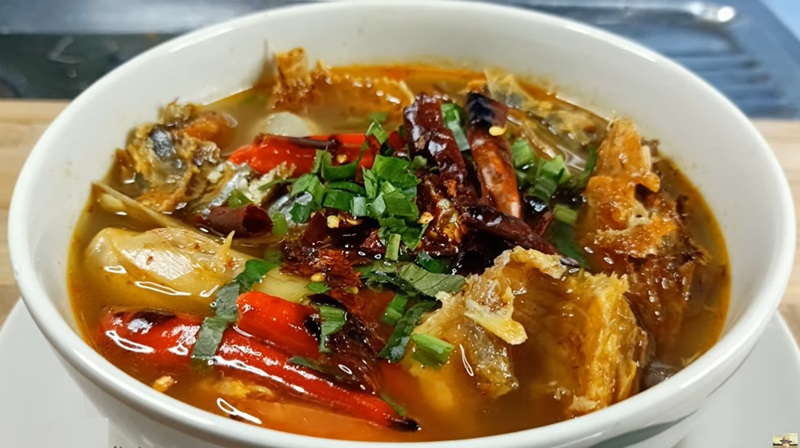
Tom khlong, a tantalizing Thai soup, marries sour and spicy flavors with smoked dried fish and an array of aromatic herbs. Akin to its well-known counterpart, tom yum, tom khlong distinguishes itself by incorporating dried or roasted herbs, infusing the soup with a distinctive depth of flavor.
Ancient Thai people affectionately referred to tom khlong as "tom hok ue," a playful onomatopoeic term capturing the sound made when sipping the soup. This whimsical moniker reflects the refreshing sensation that the soup imparts, encapsulating a delightful auditory and gustatory experience.
The soup's foundation comprises smoked dried fish, creating a rich umami essence that harmonizes with the bold and zesty combination of herbs. Tom khlong stands as a testament to the culinary ingenuity of Thai cuisine, offering a unique sensory journey that captivates taste buds with each spoonful. This traditional Thai dish, with its nuanced blend of flavors and cultural significance, remains a cherished and flavorful addition to the diverse tapestry of global gastronomy.
Nam Kaeng Hua Chai Thao
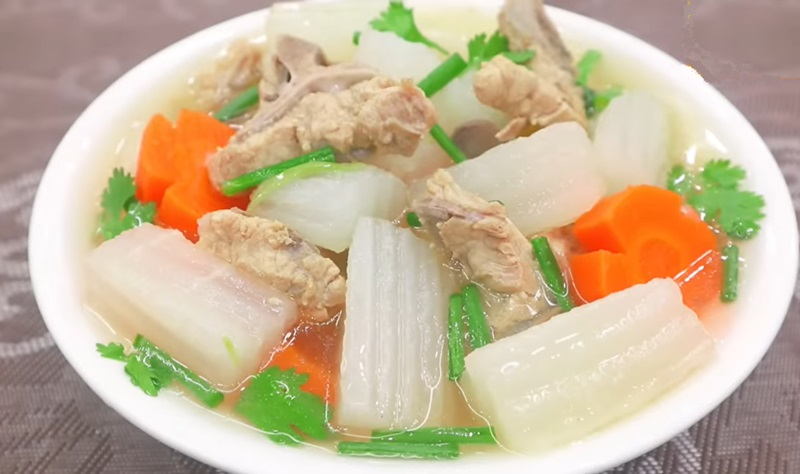
Nam kaeng hua chai thao, a Thai-Chinese radish soup, stands at the crossroads of culinary traditions, harmonizing flavors in perfect synchrony. Traditionally paired with chicken steamed rice (khao man kai), this delightful soup extends its culinary embrace to roast duck on rice (khao na pet), Thai biryani (khao mok), and Thai char siu on rice (khao mu daeng). Embodying the essence of Thai-Chinese fusion, nam kaeng hua chai thao has become a cornerstone of diverse Thai rice-based dishes.
Across Thailand, the soup unfolds into a tapestry of regional variations, showcasing the adaptability and creativity inherent in Thai culinary practices. The core ingredients of radish, ginger, pepper, and coriander dance together in a fragrant broth crafted from pork and/or chicken bones, with vegetarian renditions offering a plant-based alternative. The nuanced balance of salt and sugar elevates the soup's flavors, creating a comforting and nourishing experience for those indulging in its wholesome embrace.
Nam kaeng hua chai thao, with its roots in Thai-Chinese heritage, emerges not just as a soup but as a culinary emblem, symbolizing the diverse threads woven into Thailand's gastronomic narrative. As it graces tables across the country, this soup transcends mere sustenance, becoming a celebration of cultural confluence and culinary craftsmanship.
Tom Som
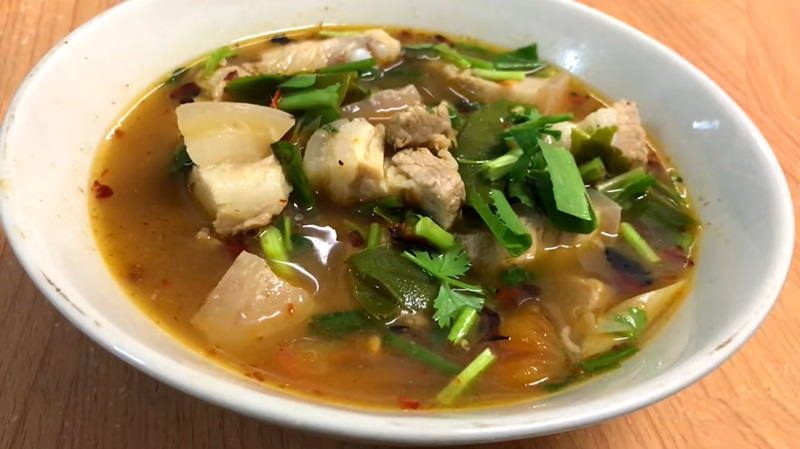
Tom som, a Thai-born sour soup, entices the palate with a vibrant interplay of flavors, typically enriched with seafood or succulent chicken. This Thai culinary gem stands out for its distinctive sour profile, creating a tantalizing symphony that captivates the senses.
In the heart of tom som lies the artful blend of essential Thai ingredients, weaving together a tapestry of taste that mirrors the country's rich culinary heritage. The soup's base, crafted with precision, often features a harmonious medley of lemongrass, lime leaves, galangal, and chilies, each contributing to the symphony of sour notes that define this gastronomic creation.
Whether adorned with the briny essence of seafood or the comforting familiarity of chicken, tom som's sour embrace is a culinary voyage, celebrating the bold and nuanced flavors for which Thai cuisine is renowned. As a cherished component of Thailand's culinary repertoire, tom som reflects the nation's mastery in transforming simple ingredients into a complex and satisfying symphony for the taste buds.
Hot and Sour Soup
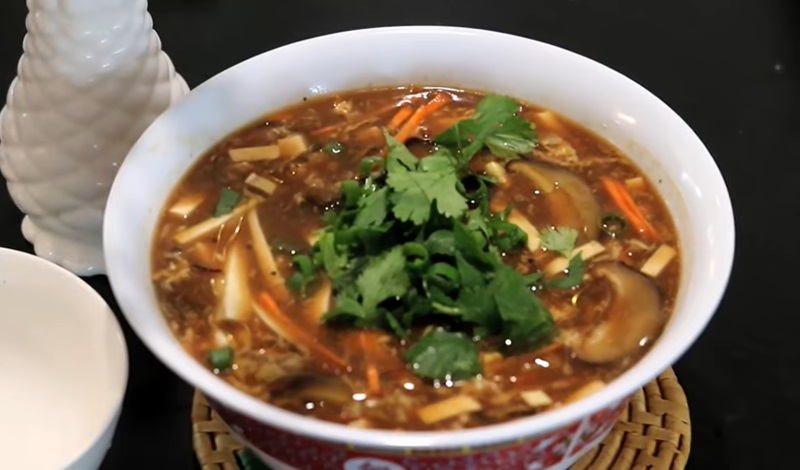
Hot and sour soup, a beloved representative of Sichuan cuisine, transcends borders with variations found in Henan, near Beijing, and within Henan cuisine, where it might be recognized as hulatang or pepper hot soup. This delectable soup has become a culinary ambassador, winning hearts in Southeast Asia, India, Pakistan, and the United States. Its flexibility allows for ingredient substitutions or additions based on availability, showcasing its adaptability to diverse palates. The American-Chinese rendition, for instance, often incorporates corn starch, resulting in a thicker consistency. Meanwhile, in Japan, a touch of sake is a distinctive addition, contributing to the soup's nuanced flavor profile.
Hot and sour soup stands as a testament to the global appreciation of its dynamic blend of heat and acidity, making it a cherished dish that transcends cultural boundaries and delights taste buds worldwide.


